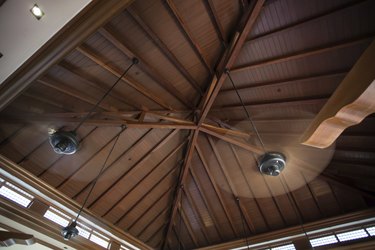
Fans can't match the raw cooling power of air conditioning units, especially in warm climates, but the air circulation provided by ceiling fans or a whole house fan can make a house feel substantially cooler for a fraction of the energy cost of a central AC unit.
Ceiling Fan Energy Usage
Video of the Day
The electricity consumption of a ceiling fan ranges widely depending on the design and the speed setting of the fan. When set at low speed, fans use between 15 and 30 watts, and at high speed, they consume between 50 and 100 watts; energy usage of about 40 watts at medium speed is typical. When used in conjunction with an air conditioner, ceiling fans may allow you to set your thermostat at a higher temperature and still be comfortable, thereby reducing your overall energy consumption. Ceiling fan motors generate heat, however, and that heat may cause your air conditioner to work harder, which will offset some of the savings on your energy bill.
Video of the Day
Typical Air Conditioner Energy Usage
A central air conditioning unit consumes much more electricity than even several ceiling fans combined; typical central AC energy consumption ranges between 2,000 and 5,000 watts per hour. A smaller window unit consumes less electricity -- about 1,200 watts for a unit that requires 12,000 British thermal units -- but it won't cool your entire house. Air conditioners, though, use all that extra energy to actually cool the air in your home; fans only circulate air and create currents that help you to feel cooler as heat is drawn away from your body.
Whole House Fans and Table Fans
Whole house fans are usually installed in an attic and are designed to move relatively cool outside air in through open windows and exhaust warm indoor air out through attic vents. Whole house fans use about 90 percent less electricity than a central air conditioning unit, and they can effectively cool your home when outdoor temperatures aren't extremely high. On the other end of the size scale are portable table fans, which are limited in their ability to create cooling air flow but which consume only 10 to 25 watts of electricity.
SEER and Energy Star Ratings
Energy efficiency ratings allow you to compare the relative efficiency of both air conditioners and fans. Air conditioners are given a rating called a seasonal energy efficiency rating. SEER is calculated by dividing an air conditioner's cooling output in Btu by its energy consumption in watts; units with a SEER of 14 or higher receive the U.S. Department of Energy's Energy Star rating. Ceiling fans may also receive an Energy Star rating if they meet standards for air flow and energy efficiency; to get the rating, for example, a fan must move at least 3,000 cubic feet of air per minute at medium speed with an efficiency of 100 cubic feet per per minute per watt.
- Florida Solar Energy Center: Development of a High Efficiency Ceiling Fan "The Gossamer Wind"
- Green Building Advisor: Using Ceiling Fans to Keep Cool Without AC
- AC Southeast: How Much Wattage Does My AC Use?
- U.S. Department of Energy: Ceiling Fans Key Product Criteria
- California Energy Commission: Wholehouse Fan
- ABS Alaskan: Power Consumption Table